A glimpse into the candlestick's role in the Bible reveals mysteries of faith, history, and prophecy, inviting deeper exploration.
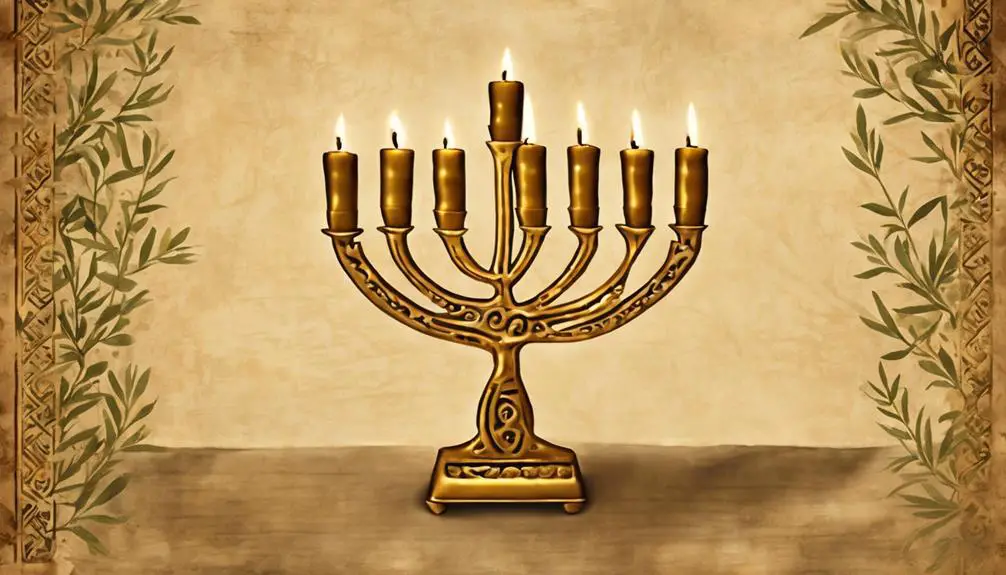
Candlestick in the Bible
Imagine you're standing in the dimly lit corridor of the ancient Temple, your eyes catch the soft glow from the Menorah, the golden candlestick prescribed in Exodus. This isn't just a relic of history; it embodies deep symbolism in temple worship and finds echoes in the Psalms and prophetic meanings that thread through to the imagery in Revelation.
You might wonder how an object so simple has woven its way through the fabric of biblical tradition and what mysteries it holds. Let's explore how this symbol has illuminated paths beyond its immediate surroundings and what it might reveal about the broader narrative it's part of.
Key Takeaways
- The candlestick symbolizes divine illumination and purity, as instructed in Exodus using pure gold.
- It serves as a beacon of spiritual enlightenment, embodying God's presence and guidance.
- In Psalms, candlesticks metaphorically represent divine guidance, enriching worship with deep contemplation.
- Revelation's imagery links candlesticks to divine presence and guidance among the seven churches.
Historical Origins in Exodus
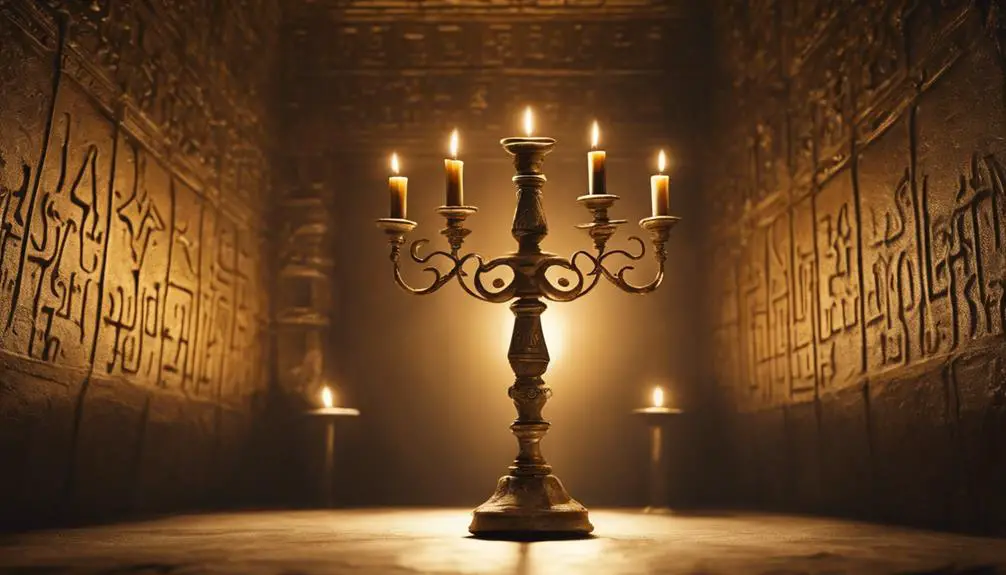
The construction and symbolism of the candlestick, as detailed in Exodus, frequently underscore its crucial role in the religious and cultural practices of ancient Israelites. You'll find that the material significance isn't just a trivial detail but deeply intertwined with its sacred function. The construction details, as prescribed, required the finest materials—pure gold, not merely an aesthetic choice but a reflection of the candlestick's divine purpose.
Delving into these construction details, you'll notice the meticulous instructions for crafting the candlestick, a testament to its importance. It wasn't merely functional; it was a symbol of divine illumination. The use of pure gold in its construction wasn't arbitrary. Gold, a material that doesn't tarnish, symbolized the purity and eternal nature of the light it was meant to hold, reflecting an unending divine presence.
These elements, the material significance and the precise construction details, weren't just about creating a religious artifact. They were about embodying the divine in a tangible form. The candlestick stood as a constant reminder of the Israelites' connection to their deity, a physical manifestation of spiritual light and purity.
Symbolism in Temple Worship
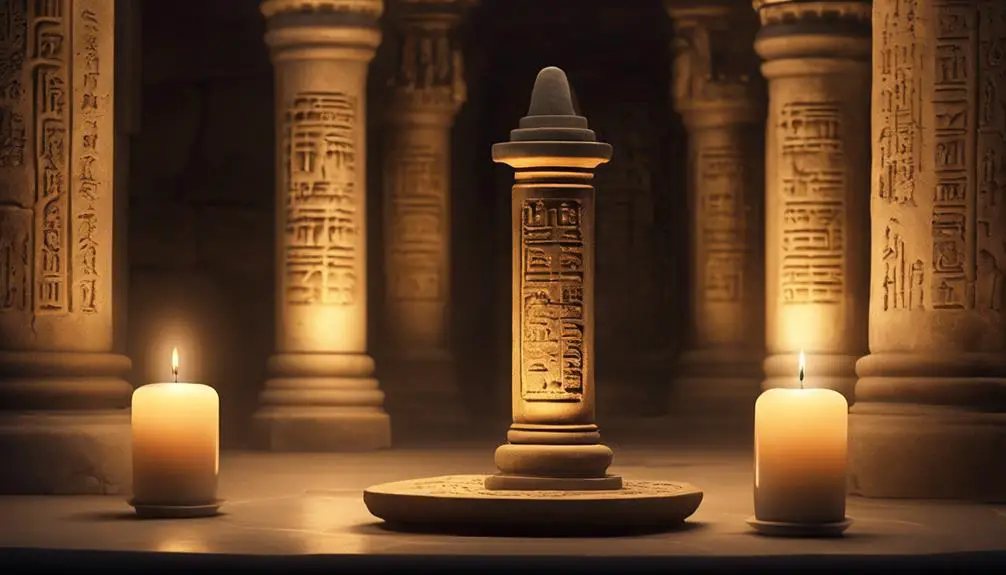
Building on the foundational understanding of the candlestick's construction and material significance, we now turn our attention to its profound symbolism within temple worship. The candlestick, or menorah, wasn't merely a source of physical light but also a beacon radiating spiritual illumination. Its perpetual flame symbolized the eternal presence of God among His people, emphasizing the necessity of continual devotion and worship.
The significance of oil in this context can't be overstated. It served as more than just fuel for the flames; it was a symbol of purity, dedication, and the anointing of the Holy Spirit. The meticulous process of preparing the oil, ensuring it was clear and undefiled, mirrored the spiritual preparation and purification required of the worshippers themselves.
Light rituals within the temple further underscored this symbolism. The act of lighting the menorah each evening and maintaining its flames showcased the priests' role in fostering a ceaseless connection between the divine and the earthly realms. This ritualistic lighting reinforced the concept of light overcoming darkness, guiding the faithful towards wisdom and away from ignorance.
In essence, the candlestick's presence in temple worship served as a multifaceted symbol, intertwining notions of divine presence, spiritual purity, and the perpetual quest for enlightenment.
Representations in Psalms
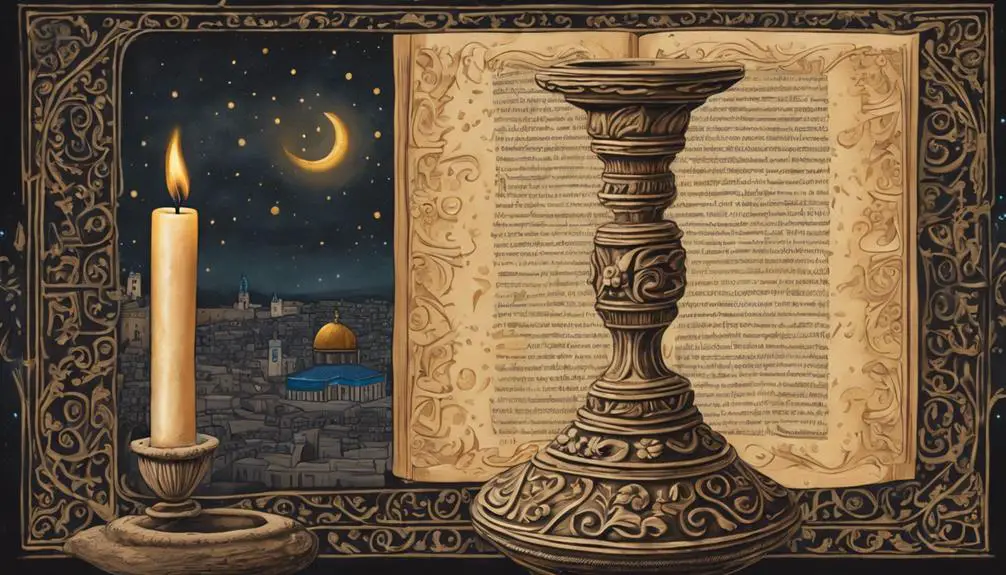
Within the Psalms, candlesticks are metaphorically used to represent God's guidance and enlightenment, offering profound insights into the spiritual journey of the faithful. This imagery, steeped in poetic devices, invites personal reflections and a deeper understanding of divine presence. Candlesticks, with their inherent symbolism of light, guide the reader through a labyrinth of spiritual awakening and renewal.
The Psalms utilize an array of poetic devices to enrich this metaphorical imagery. Parallelism, a hallmark of Hebrew poetry, emphasizes the candlestick's role as a beacon of God's enduring guidance. Similes and metaphors further illuminate the relationship between the divine light and the human soul, crafting a vivid tapestry of spiritual enlightenment. These elements, combined with the deeply personal tone of the Psalms, foster a unique space for individual contemplation and connection with God.
This intricate use of language and symbolism in the Psalms does more than just depict God's guidance; it actively engages the believer in a journey of personal growth and divine discovery. Through the metaphor of the candlestick, the Psalms underscore the transformative power of God's light in guiding the faithful through darkness, towards spiritual clarity and understanding.
The Menorah's Prophetic Meaning
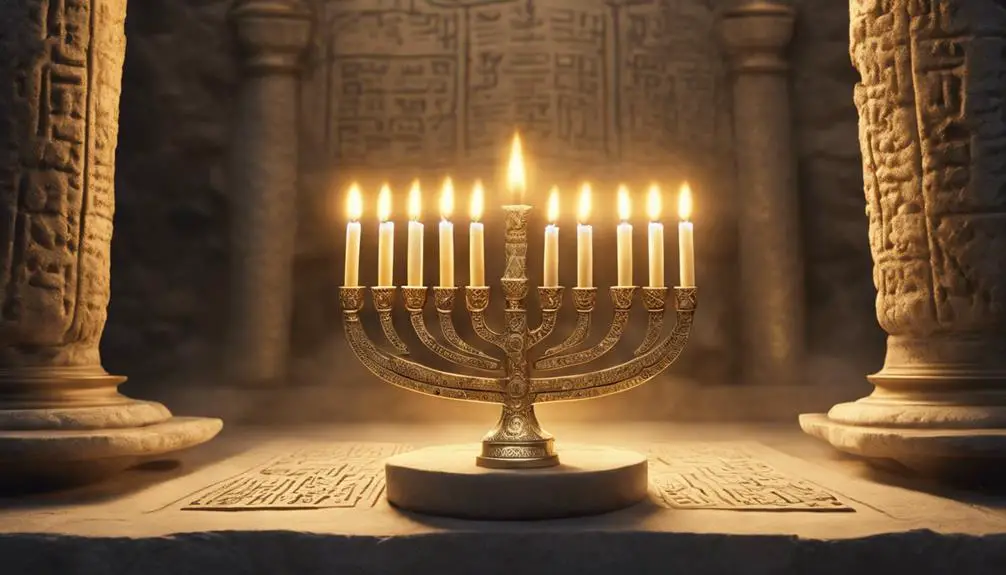
Delving into the prophetic significance of the Menorah, it's crucial to recognize its role as not merely a ceremonial artifact but as a symbol deeply embedded with eschatological promises and divine revelations. The Menorah's design and function in the ancient Tabernacle and later in the Temple hold layers of meaning that have unfolded across centuries, influencing both religious thought and architectural designs.
Modern interpretations of the Menorah explore its representation as a beacon of enlightenment, guiding the faithful through spiritual darkness. It's seen as a bridge between the divine and the mortal, a conduit for prophetic visions and a harbinger of a future where light overcomes darkness.
Aspect |
Significance |
|---|---|
Seven Branches |
Symbolizes completeness and perfection, often associated with divine intervention in human affairs. |
Pure Gold |
Represents purity and divine glory, reflecting God's incorruptible nature. |
Almond Blossoms |
Signify watchfulness and the promise of renewal, a nod to the perpetual nature of God's covenant. |
Architectural Influence |
Inspired designs in religious and secular buildings, emphasizing the Menorah's enduring legacy. |
These elements underscore the Menorah's role as not just a historical artifact but a living symbol of prophetic truths and divine presence, continually influencing modern interpretations and architectural expressions.
Candlestick Imagery in Revelation
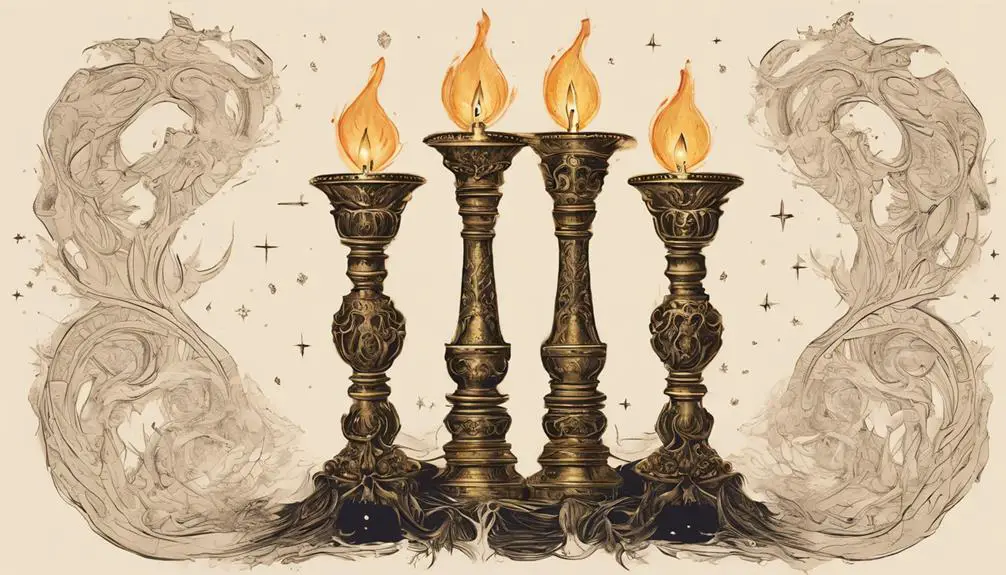
Shifting our focus to the New Testament, we encounter the rich symbolism of candlestick imagery in the Book of Revelation, which offers a profound exploration of divine presence and eschatological themes. This imagery isn't merely decorative but serves as a crucial element in the tapestry of Revelation's apocalyptic symbolism, guiding your understanding of the narrative's deeper meanings.
The candlesticks, or lampstands, in Revelation are emblematic of the seven churches to which the text is addressed. This connection underscores the churches' role as bearers of light in a world shrouded in the darkness of impending trials and tribulations. This symbolism is steeped in the prophetic tradition, linking the churches directly to the divine presence and their mission in the end times interpretation.
Analyzing these symbols, you'll find that they offer a dual message. On one hand, they represent the divine guidance and presence safeguarding the faithful during periods of persecution and hardship. On the other, they serve as a stern reminder of the vigilance and purity required of believers in facing the moral and spiritual challenges of the end times.
This intricate interplay of symbols in Revelation thus enriches your understanding of its eschatological message, framing the candlesticks not just as objects, but as vivid representations of divine light amid darkness, guiding humanity through the final chapters of its spiritual journey.
Frequently Asked Questions
How Do Modern Christian Denominations Interpret the Use of Candlesticks in Their Worship Practices Today, and Does This Vary Significantly Between Them?
Modern Christian denominations vary in their use of candlesticks during worship, incorporating both traditional candle-making techniques and, in some cases, scented candles to enhance the spiritual ambiance.
This practice significantly differs among denominations, with some viewing candlesticks as essential to creating a sacred space, while others prioritize them less. The choice often reflects theological perspectives and the desire to connect historical traditions with contemporary worship experiences.
Are There Any Documented Cases of Early Christian Communities or Churches Using Candlesticks in Ways That Differed From Jewish Traditions?
Yes, early Christian communities did use candlesticks differently from Jewish traditions. They incorporated unique candle making techniques and integrated liturgical colors into their designs, signaling specific times of the Christian liturgical year.
This adaptation allowed them to visually communicate the theological significance of events and seasons. These practices, evolving over time, underscored the distinct identity and theological expressions of early Christianity, setting a foundation for varied interpretations and uses in modern denominations.
What Is the Significance of Candlestick Holders Found in Archaeological Sites Dating to the Early Christian Period, and How Do These Compare to Jewish Artifacts From the Same Era?
You're diving into the significance of early Christian candlestick holders found through archaeological methodologies, contrasting them with Jewish artifacts. These finds, analyzed for manufacturing techniques, reveal nuances in religious practices and cultural adaptation.
How Have Artists and Sculptors Throughout Christian History Depicted Biblical Candlesticks in Their Works, and What Theological Messages Were They Aiming to Convey Through These Representations?
Throughout Christian history, artists and sculptors have depicted candlesticks with deep material symbolism, showcasing artistic evolution.
You'll find that these representations often carry theological messages, reflecting the light of faith and divine presence.
These renditions, evolving from simple designs to intricate masterpieces, not only highlight the artist's skill but also delve into the spiritual significance, aiming to illuminate the viewer's understanding of sacred narratives and the enduring power of faith.
In Contemporary Times, How Do Interfaith Dialogues Address the Shared Symbolism of the Candlestick Between Judaism and Christianity, and What Common Ground Is Found in These Discussions?
In contemporary discussions, you'll find that cultural exchanges during interfaith dialogues delve deeply into the symbolic interpretations of the candlestick. These conversations often reveal a rich tapestry of shared meanings, transcending religious boundaries.
Conclusion
In examining the candlestick's multifaceted symbolism within biblical texts, you've ventured from its historical origins in Exodus, through its ceremonial significance in Temple worship, to its poetic representations in Psalms.
Furthermore, you've explored the Menorah's prophetic meaning and its vivid imagery in Revelation. This journey underscores the candlestick's enduring spiritual and eschatological importance, encapsulating its role as a beacon of divine presence, guidance, and revelation across the canon, reflecting a deep, layered theological significance that transcends mere historical artifact.


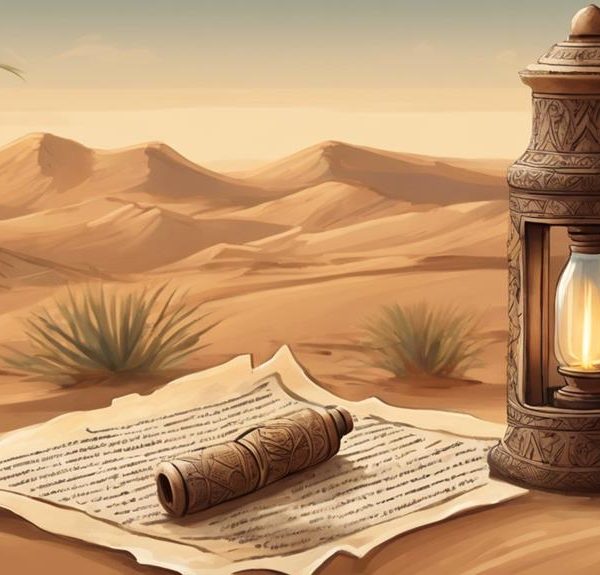
Sign up